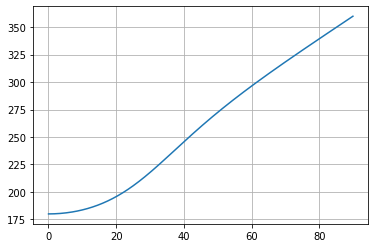6.3.1. Fresnel equations
Here, we check the functioning of Fresnel equations, that is, how a plane wave reflects and refracts on a plane surface. The refraction index of the media are n1 for the incicent media and n2 for the second media. The second media can be absorbent \(n_c = n + i \kappa\).
For the computations, we have used two ways:
- fresnel_equations_kx: When the plane plane is defined as k = (kx, kz).
- fresnel_equations: When the plane wave is define by the angle.
We have also methods to determine the reflectance and transmittance.
- transmitances_reflectances_kx
- transmitances_reflectances
One of the parameters of the funcions is ‘ouput’. It admits a list of 4 booleans to check whether we want to compute this parameter or not. The order is:
- t_TM, t_TE, r_TM, r_TE
Also, inside each method, we can obtain the drawing of the Fresnel equation or the reflectance. The parameters are:
- has_draw: boolean
- kind: 'amplitude_phase' or real_imag
[1]:
%load_ext autoreload
%autoreload 2
[2]:
import numpy as np
import matplotlib.pyplot as plt
from diffractio import um, mm, degrees
from diffractio.utils_optics import fresnel_equations_kx, fresnel_equations, transmitances_reflectances_kx, transmitances_reflectances
6.3.1.1. Fresnel with kx
We introduce the vector kx, which is useful mainly for algorithm programming.
[3]:
wavelength = 0.6328*um
n1 = 1
n2 = 1.5
n2c = 1 + 5j
k0 = 2 * np.pi / wavelength
theta = np.linspace(0.01, np.pi/2-0.01, 361)
[4]:
# Here is the kx parameter, which need to be computed in the input side.
kx = k0 * n1 * np. sin(theta)
t_TM, t_TE, r_TM, r_TE = fresnel_equations_kx(kx,wavelength, n1, n2, has_draw=True, kind='real_imag')
t_TM, t_TE, r_TM, r_TE = transmitances_reflectances_kx(kx, wavelength, n1, n2, has_draw=True)
/home/luismiguel/.local/lib/python3.10/site-packages/matplotlib/cbook/__init__.py:1298: ComplexWarning: Casting complex values to real discards the imaginary part
return np.asarray(x, float)
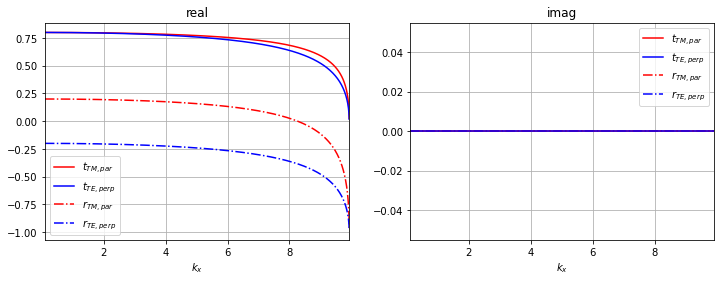
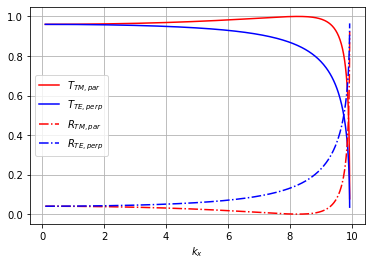
6.3.1.2. Fresnel with angles \(\theta\)
This case is more suitable to understand what happens at the boundaries of a surface
[5]:
wavelength = 0.6328*um
n1 = 1
n2 = 1.5
n2c = 1 + 5j
k0 = 2 * np.pi / wavelength
theta = np.linspace(0.001, np.pi/2-0.001, 361)
6.3.1.2.1. \(n_2 > n_1\)
[6]:
t_TM, t_TE, r_TM, r_TE = fresnel_equations(theta, wavelength, n1, n2, [1,1,0,0], has_draw=True, kind='real_imag')
T_TM, T_TE, R_TM, R_TE = transmitances_reflectances(theta ,wavelength, n1, n2, has_draw=True)
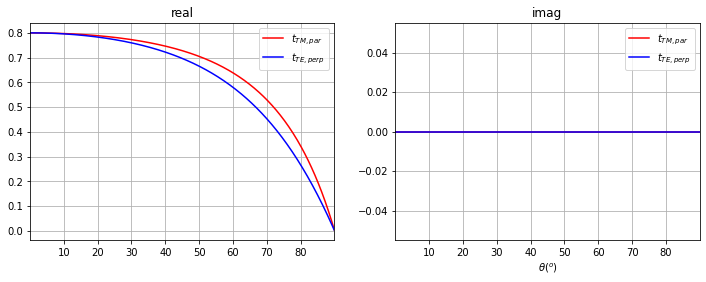
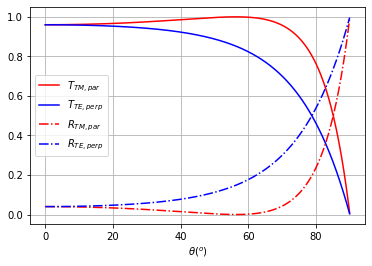
We can se Brewster angle.
6.3.1.2.2. \(n_2 < n_1\)
[7]:
t_TM, t_TE, r_TM, r_TE = fresnel_equations(theta, wavelength, n1, n2, has_draw=True, kind='real_imag')
T_TM, T_TE, R_TM, R_TE = transmitances_reflectances(theta ,wavelength, n1, n2, has_draw=True)
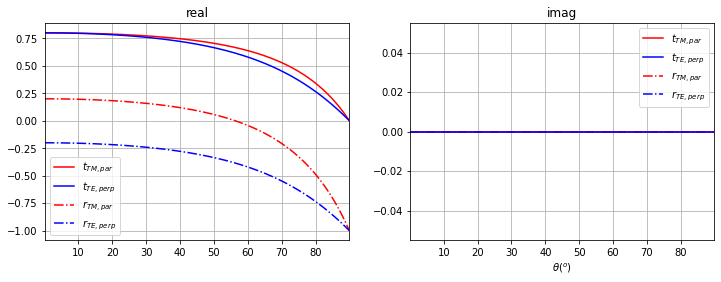
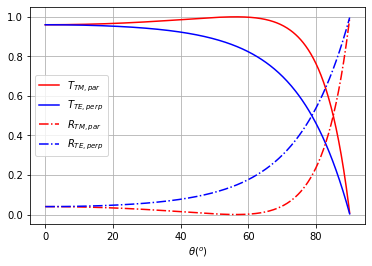
6.3.1.2.3. \(n_2 > n_1\)
Here total internal refraction is clear. i nthe amplitude/phase representation.
[8]:
t_TM, t_TE, r_TM, r_TE = fresnel_equations(theta ,wavelength, n2, n1, has_draw=True, kind='amplitude_phase')
T_TM, T_TE, R_TM, R_TE = transmitances_reflectances(theta ,wavelength, n2, n1, has_draw=True)

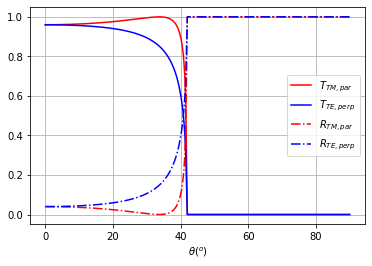
Phase difference between the two polarizations
[9]:
plt.plot((np.angle(r_TE)-np.angle(r_TM))/degrees)
plt.grid()

6.3.1.2.4. \(n_2 = n + i \kappa\)
This case is when the second medium present a complex refractive index, as in metals.
[10]:
t_TM, t_TE, r_TM, r_TE = fresnel_equations(theta, wavelength, n1, n2c, has_draw=True, kind='real_imag')
T_TM, T_TE, R_TM, R_TE = transmitances_reflectances(theta, wavelength, n1, n2c, has_draw=True)
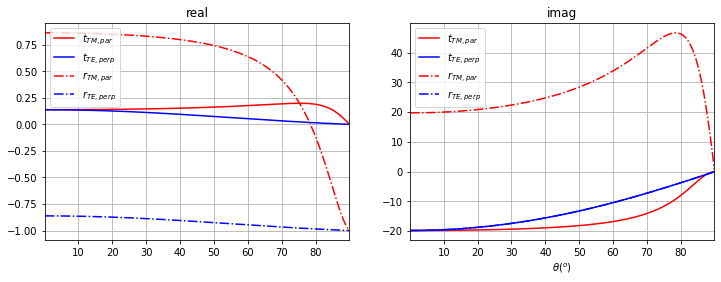
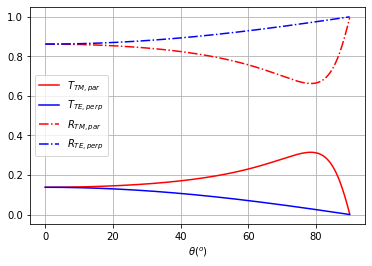
Phase difference between the two polarizations
[11]:
plt.plot(theta/degrees, (np.angle(r_TE)-np.angle(r_TM))/degrees)
plt.grid()
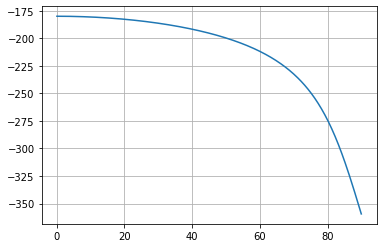
6.3.1.2.5. \(n_1 = n + i \kappa\)
This case is more strange, as the first medium is complex, it absorbs the light field, but it may be interesing when it is a thin metallic layer.
[12]:
n2c = 1 + 1j
[13]:
t_TM, t_TE, r_TM, r_TE = fresnel_equations(theta, wavelength, n2c, n1, has_draw=True, kind='real_imag')
T_TM, T_TE, R_TM, R_TE = transmitances_reflectances(theta, wavelength, n2c, n1, has_draw=True)
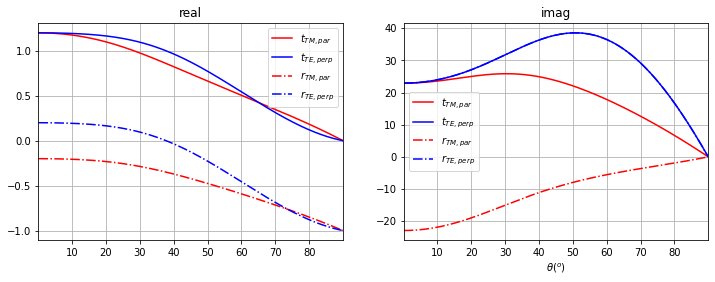
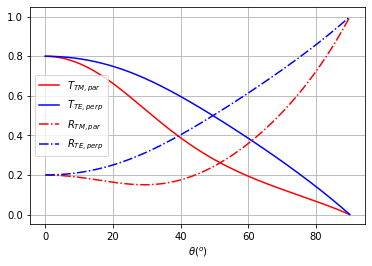
Phase difference between the two polarizations
[14]:
plt.plot(theta/degrees, (np.angle(r_TE)-np.angle(r_TM))/degrees)
plt.grid()
